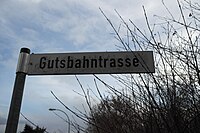Gutsbahn Dahlewitz
| Gutsbahn Dahlewitz | |||||||||||||||||||||
|---|---|---|---|---|---|---|---|---|---|---|---|---|---|---|---|---|---|---|---|---|---|
|
The street Gutsbahntrasse in town is reminiscent of the railway
| |||||||||||||||||||||
| Route length: | 2.5 km | ||||||||||||||||||||
| Gauge : | 1435 mm ( standard gauge ) | ||||||||||||||||||||
| Power system : | unknown = | ||||||||||||||||||||
|
|||||||||||||||||||||
The Gutsbahn Dahlewitz was a connecting line operated from 1895 to 1945 from the Dahlewitz station on the Berlin – Dresden railway line to the Dahlewitz estate . The line was electrified as early as 1904. This makes it one of the earliest examples of electrical railway operations in Prussia .
history
The Berlin architect Wilhelm Böckmann took over the Dahlewitz estate ( called Dahlwitz until 1905 ) in 1896 and converted the estate into a modern model estate in the following years. Among other things, Böckmann had a Prussian railway regiment built a siding in gravel bedding from the Dahlewitz station on the Berlin-Dresden railway to the estate. The track material came from Orenstein & Koppel from used stocks. Initially, the wagons were pulled by horses, but this did not work, and after three months a battery locomotive from Siemens & Halske was purchased. In cooperation with the Siemens-Schuckert works in Berlin, the line was provided with an overhead line in autumn / winter 1903/1904 and the electrified line was put into operation on April 1, 1904. The electricity was generated in a boiler house near the distillery, which was supplied with coal by the railway. The electricity was also used to supply the estate and to pump water into the estate's water tower, which was built at the same time as the railway and was probably designed by Böckmann. The purpose of the railway was to transport agricultural goods and the products of the distillery on the estate. In addition to coal, the estate probably also received fertilizers and building materials. A coal shop opposite the estate was also supplied with coal via the railway.
In 1943 there was a collision with a truck at the intersection with today's Thälmannstraße, in which the locomotive was damaged but could still be used. In 1945 the property was expropriated. Nothing is known about the whereabouts of the locomotive and the rails. There are suspicions that the tracks went to the Soviet Union as reparations , but the poor condition of the tracks at the time speaks against this. It is also assumed that the rails served as ceiling beams in new farm houses built after the land reform.
course
The approximately 2.5 km long route began east of Dahlewitz train station. There was a butt track and a transfer track for the locomotives. The area was built over after 2000, where the Dahlewitz community library was built. In the southern part of the station there was a connecting track from the main track in the direction of Berlin to the Gutsbahn. Wagons destined for the Gutsbahn from Berlin had to be brought to Rangsdorf station and then driven back to Dahlewitz. From there the route turned in an arc to the east. The course of the route can be seen on some trees standing in a field. It then ran south of the current development of the place, the street name Gutsbahntrasse today reminds of the course of the route. At the intersection with today's Thälmannstraße there was a head ramp with a loading track, so that loading and unloading was also possible there. The route between today's Thälmannstrasse and the intersection with Dorfstrasse has meanwhile been built over. It ended on the northwest side of the Dahlewitz estate. Next to the distillery there was the locomotive shed of the railway, which has been preserved.
vehicles
The railway had a locomotive, a unique specimen without a series designation. This was probably the converted battery locomotive, which was converted into an electric locomotive and fitted with a pantograph on the roof of the driver's cab. In addition, there were at least two covered freight wagons owned by the railroad track with the inscription “Dom. Dahlwitz - Dresdener Bahn ”, presumably refrigerated car for milk transport. Furthermore, various freight cars of the state railway drove on the route.
literature
- Rainer Pannier: First, robust farm horses pulled the freight wagons. Infrastructure. The Gutsbahn Dahlewitz. From horse and battery operation to electrification via overhead lines. In: Märkische Allgemeine Zeitung , Jüterboger Echo , from January 21, 2011.
- Rainer Pannier: The electricity came from the Guts generator. Infrastructure. The electric locomotive of the former Gutsbahn Dahlewitz was unique, the track of which is lost in 1946. In: Märkische Allgemeine Zeitung, Jüterboger Echo , from January 28, 2011.
- Uwe Kerl, Wolfgang Kramer: The connecting railway Dahl (e) witz. In: Berliner Verkehrsblätter , 58th year 2011, No. 3, p. 44 f.
Web links
Individual evidence
- ↑ 1897 The water tower in Dahlewitz on historisches-dort-dahlewitz.de, accessed on December 28, 2012
- ↑ a b c Rainer Pannier: First robust farm horses pulled the freight wagons. Infrastructure. The Gutsbahn Dahlewitz. From horse and battery operation to electrification via overhead lines. In: Märkische Allgemeine Zeitung , Jüterboger Echo , from January 21, 2011.
- ↑ a b c d e Uwe Kerl, Wolfgang Kramer: The connecting railway Dahl (e) witz. In: Berliner Verkehrsblätter , 58th year 2011, No. 3, p. 44 f.
- ↑ a b c d e f g Rainer Pannier: The electricity came from the Guts generator. Infrastructure. The electric locomotive of the former Gutsbahn Dahlewitz was unique, the track of which is lost in 1946. In: Märkische Allgemeine Zeitung, Jüterboger Echo , from January 28, 2011.


